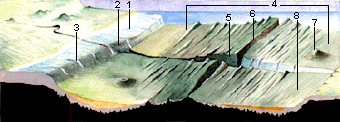The Ocean Floor
The floor of the Ocean has a complex structure caused by horizontal and vertical tectonic motions, breaks in the Earth's crust, volcanic activity, sedimentation and other factors. The whole diversity of underwater relief forms is classified in the following main categories, including large areas of the Ocean: continental margins, transition zones, Ocean floor and mid-ocean ridges. Continental margins are areas where a transition from continents to Oceans occurs. They include the continental shelf, slope, and foot. The shelf originated from a time when flat, coastal areas became inundated due to an increase in the height of sea-level from previous times. The width of the shelf varies, from tens to hundreds kilometres, and its depths can vary from 80-100m to as deep as 450-500 m.
The continental slope adjoins the shelf, framing the continental borderland. The slope can be slanted, moderately steep, cut by underwater canyons or step-like in which case the slope has a variable or blocky steepness. Slopes vary from 1�-2� up to 20�-30� and more. The bottom of the slope reaches depths of 3,000-3,500 m, where it changes to a very low grade of flatness at the continental foot. The continental foot is characterised by the existence of great thicknesses of sediment accumulations. The transition zone is characterised by a change from continental crust to oceanic crusts. The densities of these crusts are very different. Island arcs, deep-water troughs and fringing basins are formed in the transition zone. The bottoms of basins are frequently flat, caused by the expanse of great thicknesses of sediments. However, they often contain rises, ridges and seamounts. The island arcs separate fringing basins from the Ocean, and are formed where oceanic plates collide. They are large underwater platforms on top of which are volcanoes or volcanic islands. The outer edges of island arcs are often bordered by narrow, steep-walled troughs and trenches some of which show depth maxima of up to 8,000-10,000 m.The Ocean floor covers extensive areas and can be divided into a series of basins. The predominant depths of basins are 4,500-5,500 m. The surface of the Ocean floor is interrupted by ridges, plateaus, seamounts, guyots and underwater mountains chains.



